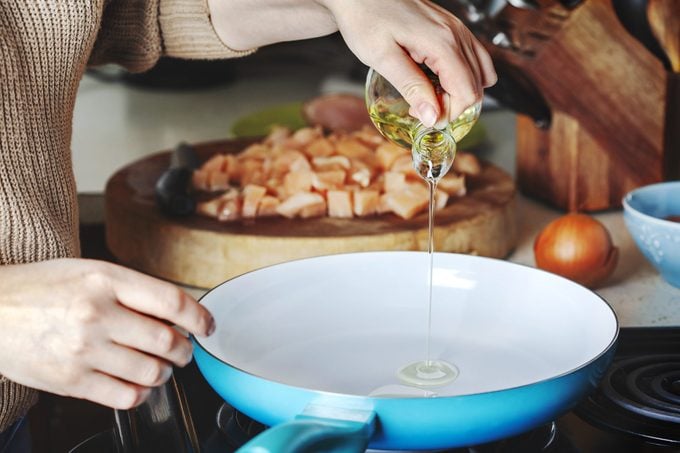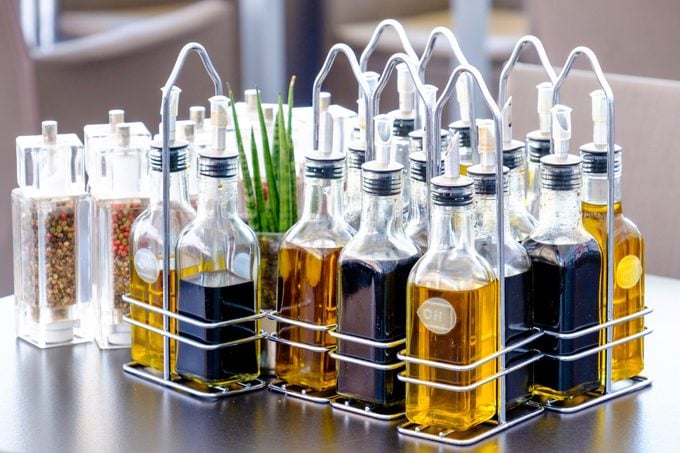Avocado Oil vs. Olive Oil: Is One Healthier Than the Other?
Updated: Aug. 30, 2021
Wondering whether you should use avocado or olive oil in the kitchen? Read on for the answer, according to experts.
The battle of the oils
Both avocado oil and olive oil are extraordinary ingredients to add to your kitchen rotation.
“Extensive research has shown that chronic low-grade inflammation and oxidative stress are detrimental to overall health and well-being,” says Jody Bergeron, RN, a critical care nurse for Cape Cod Healthcare. “The Mediterranean diet focuses on anti-inflammatory and nutrient-dense foods.”
Both avocado oil and olive oil would be considered part of a Mediterranean diet-style of eating.
Bergeron recommends making small dietary changes, and replacing saturated fat options—butter, palm oil, cream-based dressings, lard, and mayonnaise—with avocado or olive oil. “Your body will reap all the benefits,” Bergeron says.
But when it comes to choosing avocado oil vs. olive oil, is one option better?
We asked nutrition experts to find out the answer.
What is avocado oil?
Avocado oil is typically extracted from the avocado fruit via cold-press extraction.
Per tablespoon, avocado oil contains 124 calories, 10 grams monounsaturated fat, 2 grams polyunsaturated fat, and 2 grams saturated fat.
Back in 2000, two companies in New Zealand began producing extra-virgin avocado oil. In doing so, they created cold-pressed avocado oil, according to the American Oil Chemists’ Society (AOCS).
Now, producers in Chile, South Africa, and Kenya are also processing extra-virgin avocado oil.
Avocado oil is created through a mechanical process. After removal of the skin and seed, the avocado flesh is ground to a paste, according to the AOCS.
Next, the paste is slowly churned for up to an hour at a temperature range of 115 to 122 F. After the paste goes through separation steps, you have avocado oil.
Even though the process is at a slightly higher temperature than for some other oils, this final product is still considered cold-pressed avocado oil and features the flavor of the fresh fruit.
What are the types of avocado oil?
Many varieties of avocado oil exist. This includes extra-virgin avocado oil, produced from high-quality fruit and extracted via mechanical methods with a temperature below 122 F. In this process, there are no chemical solvents.
You’ll also find virgin avocado oil, which has similar guidelines to extra-virgin olive oil but is produced from a lower-quality fruit, according to 2019 research in Molecules.
Also on the market is pure avocado oil. This is bleached and deodorized—and then infused with natural fruit or herb flavor.
There is also mixed avocado oil, which is typically combined with olive, macadamia, as well as other types of oil, according to the Molecules study.
Nutritional benefits of avocado oil
“Avocado oil is rich in the heart-healthy monounsaturated fat, oleic acid,” explains registered dietitian nutritionist Laura M. Ali, a culinary nutritionist in Pittsburgh, Pennsylvania.
Indeed, in a small study in the Journal of Functional Foods, replacing butter with avocado oil led to reduced total cholesterol, triglycerides, and LDL cholesterol levels and improved inflammatory markers.
Additionally, avocado oil boasts the carotenoid lutein. “Like the avocado fruit, the oil also contains lutein, an antioxidant important for eye health,” adds Ali.
(Here are some other healthy butter substitutes.)

What is olive oil?
Olive oil production dates back to the beginning of human agriculture.
It contains 124 calories, 10 grams monounsaturated fat, 1 gram polyunsaturated fat, and 2 grams saturated fat, per tablespoon.
The wild olive tree comes from Asia Minor, and experts believe that it spread from Syria to Greece, according to the International Olive Council (IOC). However, another theory supports that the olive tree originated in lower Egypt, Nubia, Ethiopia, the Atlas Mountains, or specific areas of Europe.
Today, olive tree farms are everywhere from the Mediterranean to China, Japan, Africa, and Australia.
Olive oil was first made by squeezing fallen olives with a stone mortar, according to the AOCS. These days, there are three extraction processes: pressure, percolation, and centrifugation.
The latter is the most common method. The process begins with olive harvesting, and the health and ripeness of the harvested olives determine an olive oil’s quality.
After olives are harvested, they’re transported to an olive mill. Then foreign materials are removed from the batch, and the olives are washed.
Next, olives are placed onto a moving belt, where the olives are crushed. The olive paste is slowly stirred, and the paste’s temperature is controlled—it cannot climb higher than 86 degrees F—to avoid the olives changing color.
Finally, the olive oil is separated from other constituents.
What are the types of olive oil?
Many forms of olive oil exist, according to the IOC. Virgin olive oils are defined by their free acidity levels, with extra-virgin olive oil containing the lowest level.
“Extra virgin means that the oil was not refined of its flavor, color, or smell and that it contains the highest level of nutrients,” says Nicole Stefanow, a registered dietitian nutritionist in the New York City area.
Then there’s refined olive oil obtained from virgin olive oils by refining methods that don’t lead to structural alterations. Olive oil is a blend of refined olive oil and virgin olive oil.
(These are the best olive oil cooking sprays.)
Nutritional benefits of olive oil
“Low-grade chronic inflammation plays a role in the development of cardiovascular disease and metabolic syndrome, a group of conditions that increase your risk for heart disease, stroke, and type 2 diabetes,” says Stefanow.
“Foods high in oleic acid and vitamin E, like olive oil, can contribute to reduced inflammation and may help prevent chronic disease.”
Additionally, olive oil boasts a type of unsaturated fat called monounsaturated fat. “This type of fat is known to improve heart health,” explains Ali.
“A study in Journal of the American College of Cardiology of over 90,000 adults found that people who ate a diet rich in olive oil had an up to 7 percent lower rate of coronary heart disease when olive oil was used in place of saturated fat,” Ali says.
“Olive oil is also rich in antioxidants and polyphenols, nutrients in plants that have been shown to support heart health, brain health, and our immune systems.”
Safety concerns of avocado and olive oil
“Both avocado oil and olive oil are sensitive to light and heat,” says Ali. So store them in a cool, dark place and in a dark-colored container.
“I keep both oils in the refrigerator to preserve the flavor and nutrition,” she adds. “Just pull them out a half-hour before using to bring them to room temperature.”
Also, take note of the smoke points of both cooking oils. Refined avocado oil can withstand a smoke point of up to 500 F, while extra-virgin olive oil has a smoke point of 405 F.
“If an oil is heated at too high a temperature, it starts breaking down,” explains Ali. This will change the oil’s flavors and lead to burning—and also lead to a degradation of the oil’s quality.
“Olive oil is best saved for low-temperature cooking like sautéing, quick searing, and for use in dressings and dipping sauces,” says Ali. You can use avocado oil for almost anything, including higher-temperature cooking such as frying.
Also, if you have the budget for it, splurge on higher-quality—meaning extra-virgin—oils.
“In crude avocado oil, there is a high amount of chlorophyll that contributes to its emerald-green color and health profile,” says Bergeron. “Unfortunately, this can lead to a negative effect on the oxidative stability due to its easy photo-oxidation when exposed to light and oxygen.”

So which is best?
As with many questions in the world of nutrition, there’s no clear winner—both avocado oil and olive oil are terrific choices. After all, they are almost identical in calorie count, and they have similar nutritional profiles.
“Both avocado oil and olive oil have high amounts of antioxidants and vitamins like vitamin E, polyphenols, phytosterols, and squalene,” says registered dietitian nutritionist Andrea Goergen, owner of Cultivate Healthy in the Washington, DC area.
“The very small differences between the nutrients found in these two oils lies in the amount of vitamin E in each product,” notes Stefanow.
“Olive oil offers 33 percent of the daily value of vitamin E per tablespoon, whereas avocado oil offers 23 percent. Both are considered excellent sources of vitamin E and other powerful antioxidants.”
Vitamin E is involved in your body’s immune function.
However, there are instances in which you may want to choose one oil over the other.
“A pure refined avocado oil has the highest smoke point and is often recommended for very high-heat cooking,” says Bergeron. You can use it for anything from sautéing to air or deep frying.
Then you can opt for a more refined avocado or olive oil in baking, in which a more neutral-tasting oil is likely preferred. “For more flavor in salad dressings and dips, extra-virgin oils are preferable,” adds Bergeron.
Lastly, think about the dish you’re making.
“Both avocado and olive oil have distinct flavors, so I always think about the food I’m using them in,” says Ali.
“If it is a food that has a lot of strong southwestern flavors like lime, cilantro, or cumin, avocado oil is my definite go-to oil for because it blends so nicely and complements those flavors. Olive oil is delicious when used with lighter-flavored foods so its grassy notes will stand out.”
How to use avocado and olive oils in recipes
Try these healthy recipes from registered dietitians:
- Fruit Breakfast Tacos with avocado oil
- Southwest Chopped Salad over Grilled Romaine with avocado oil
- Grape Juice Salad Dressing with olive oil
- Lupini Bean Salad with olive oil
- Greek Salad Dressing with olive oil
- Homemade Pesto with olive oil






















